Difference between revisions of "AY Honors/Communications - Advanced/Answer Key"
m |
m (spelling) |
||
| (One intermediate revision by the same user not shown) | |||
| Line 14: | Line 14: | ||
# medium gap (between words) | # medium gap (between words) | ||
# long gap (between sentences) | # long gap (between sentences) | ||
| − | |||
Those learning Morse are often taught to send and understand letters and other symbols at their full target speed, that is with normal relative timing of the dots, dashes and spaces within each symbol for that speed. Exaggerated spaces between symbols and words are used to give 'thinking time', which can be reduced with practice and familiarity. This makes the sound 'shape' of the letters and symbols easier to learn. This teaching method is referred to as the '''Farnsworth method'''. Another popular teaching method is the '''Koch method''', which uses the full target speed from the outset, but begins with just two characters. Once strings containing those two characters can be copied with 90% accuracy, an additional character is added, and so on until the full character set is mastered. | Those learning Morse are often taught to send and understand letters and other symbols at their full target speed, that is with normal relative timing of the dots, dashes and spaces within each symbol for that speed. Exaggerated spaces between symbols and words are used to give 'thinking time', which can be reduced with practice and familiarity. This makes the sound 'shape' of the letters and symbols easier to learn. This teaching method is referred to as the '''Farnsworth method'''. Another popular teaching method is the '''Koch method''', which uses the full target speed from the outset, but begins with just two characters. Once strings containing those two characters can be copied with 90% accuracy, an additional character is added, and so on until the full character set is mastered. | ||
| Line 42: | Line 41: | ||
|align=center| I ||'''India''' ||'''<code>··</code>'''|| bom-bay | |align=center| I ||'''India''' ||'''<code>··</code>'''|| bom-bay | ||
|- | |- | ||
| − | |align=center| J ||''' | + | |align=center| J ||'''Juliet''' ||'''<code>·---</code>''' || where-'''FORE ART THOU?''' |
|- | |- | ||
|align=center| K ||'''Kilo''' ||'''<code>-·-</code>''' || '''POUND''' for '''POUND''' | |align=center| K ||'''Kilo''' ||'''<code>-·-</code>''' || '''POUND''' for '''POUND''' | ||
| Line 78: | Line 77: | ||
===b. Send and receive by semaphore code at the rate of 12 words per minute using semaphore flags. (Five-letter words, minimum of 20 words.)=== | ===b. Send and receive by semaphore code at the rate of 12 words per minute using semaphore flags. (Five-letter words, minimum of 20 words.)=== | ||
| − | The newer flag semaphore system uses two short poles with square flags, which a flagperson holds in different positions to signal letters of the alphabet and numbers. The flagperson holds one pole in each hand, and extends each arm in one of seven possible directions. Except for in the rest position, the flags cannot overlap. The flags are | + | The newer flag semaphore system uses two short poles with square flags, which a flagperson holds in different positions to signal letters of the alphabet and numbers. The flagperson holds one pole in each hand, and extends each arm in one of seven possible directions. Except for in the rest position, the flags cannot overlap. The flags are colored differently based on whether the signals are sent by sea or by land. At sea, the flags are colored red and yellow, while on land, they are red and white. |
{| width=100% style="text-align: center; line-height: 125%;" | {| width=100% style="text-align: center; line-height: 125%;" | ||
|- | |- | ||
| Line 125: | Line 124: | ||
* Wikipedia article on [[W:Semaphore (communication)|Semaphores]] | * Wikipedia article on [[W:Semaphore (communication)|Semaphores]] | ||
* http://www.cromwellbutlers.com/sbb_0617.htm | * http://www.cromwellbutlers.com/sbb_0617.htm | ||
| − | |||
| − | |||
Revision as of 16:55, 4 March 2007
1. Have the Communications Honor
The answers for the Communications honor can be found in the Vocational chapter of this wikibook.
2. Do one of the following:
a. Send and receive by International Morse Code at the rate of eight words per minute using flashlight, whistle, mirror, buzzer, or key. (Five-letter words, minimum of 20 words.)
Morse code is a method for transmitting information, using standardized sequences of short and long marks or pulses — commonly known as "dots" and "dashes" — for the letters, numerals and special characters of a message. Originally created for Samuel Morse's electric telegraph in the mid-1830s, it was also extensively used for early radio communication beginning in the 1890s. However, with the development of more advanced communications technologies, the widespread use of Morse code is now largely obsolete, apart from emergency use and other specialized purposes, including navigational radio beacons, and by CW (continuous wave) amateur radio operators. Morse code is the only digital modulation mode designed to be easily read by humans without a computer, making it appropriate for sending automated digital data in voice channels, as well as making it ideal for emergency signaling, such as by way of improvised energy sources that can be easily "keyed" such as by supplying and removing electric power (e.g. by switching a breaker on and off).
Morse code can be transmitted in a number of ways: originally as electrical pulses along a telegraph wire, but also as an audio tone, as a radio signal with short and long pulses or tones, or as a mechanical or visual signal (e.g. a flashing light). Because Morse code is transmitted using just two states — on and off — it was an early form of a digital code. International Morse code is composed of six elements:
- short mark, dot or 'dit' (·)
- longer mark, dash or 'dah' (-)
- intra-character gap (between the dots and dashes within a character)
- short gap (between letters)
- medium gap (between words)
- long gap (between sentences)
Those learning Morse are often taught to send and understand letters and other symbols at their full target speed, that is with normal relative timing of the dots, dashes and spaces within each symbol for that speed. Exaggerated spaces between symbols and words are used to give 'thinking time', which can be reduced with practice and familiarity. This makes the sound 'shape' of the letters and symbols easier to learn. This teaching method is referred to as the Farnsworth method. Another popular teaching method is the Koch method, which uses the full target speed from the outset, but begins with just two characters. Once strings containing those two characters can be copied with 90% accuracy, an additional character is added, and so on until the full character set is mastered.
As with other lists mnemonics may be used as a memory aid. Here is a United States version based on the NATO phonetic alphabet.
| Letter | Phonetic | Morse Code | Mnemonic (explanation) |
|---|---|---|---|
| A | Alfa | ·- |
al-FA (that's what it says!) |
| B | Bravo | -··· |
YEAH! *clap* *clap* *clap* (applause) |
| C | Charlie | -·-· |
CHAR-lie's AN-gels (1970s TV show) |
| D | Delta | -·· |
NEW or-leans |
| E | Echo | · |
hey! |
| F | Foxtrot | ··-· |
*step**step**BRUSH**step* (that's how you foxtrot!) or get a HAIR-cut |
| G | Golf | --· |
HOLE IN one! |
| H | Hotel | ···· |
ho-li-day-inn |
| I | India | ·· |
bom-bay |
| J | Juliet | ·--- |
where-FORE ART THOU? |
| K | Kilo | -·- |
POUND for POUND |
| L | Lima | ·-·· |
li-MA pe-ru (Lima is the capital city of Peru.) |
| M | Mike | -- |
LIKE MIKE (Michael Jordan advertising jingle) |
| N | November | -· |
AU-tumn |
| O | Oscar | --- |
SUN-NY-DAY (Sesame Street theme song --as in "Oscar the Grouch") |
| P | Papa | ·--· |
of DOC-TOR good (from "Gypsies, Tramps and Thieves", by Cher.) |
| Q | Quebec | --·- |
A-LOU-et-TUH (a song sung by French Canadians) or PAYDAY to-DAY |
| R | Romeo | ·-· |
ro-MER-o "Romeo" in Spanish. |
| S | Sierra | ··· |
ne-va-da (the Sierra Nevada) |
| T | Tango | - |
*DIP* (like holding a dip during a tango for a few seconds.) |
| U | Uniform | ··- |
u-ni-FORM (that's what it says!) |
| V | Victor | ···- |
*the first 4 notes of Beethoven's 5th]] (5 is the Roman numeral V* |
| W | Whiskey | ·-- |
don't DRINK IT |
| X | X-ray | -··- |
ON-ly the BONES (that's all you see in an x-ray image.) |
| Y | Yankee | -·-- |
ON a PO-NY (from Yankee Doodle) |
| Z | Zulu | --·· |
SHA-KA zu-lu (name of famous Zulu king.) |
b. Send and receive by semaphore code at the rate of 12 words per minute using semaphore flags. (Five-letter words, minimum of 20 words.)
The newer flag semaphore system uses two short poles with square flags, which a flagperson holds in different positions to signal letters of the alphabet and numbers. The flagperson holds one pole in each hand, and extends each arm in one of seven possible directions. Except for in the rest position, the flags cannot overlap. The flags are colored differently based on whether the signals are sent by sea or by land. At sea, the flags are colored red and yellow, while on land, they are red and white.
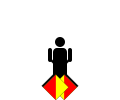 Rest position |
 Numerals |
 Attention |
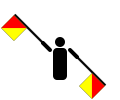 Cancel | ||
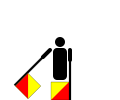 A / 1 |
 B / 2 |
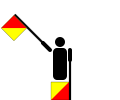 C / 3 / Ack |
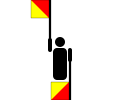 D / 4 |
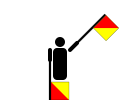 E / 5 / Error 9x's |
 F / 6 |
 G / 7 |
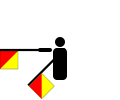 H / 8 |
 I / 9 |
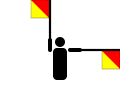 J / Letters |
 K / 0 | |
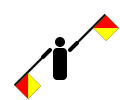 L |
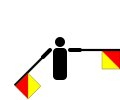 M |
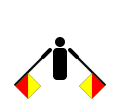 N |
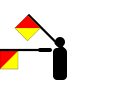 O |
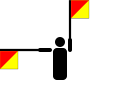 P | |
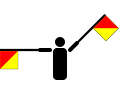 Q |
 R |
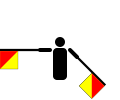 S |
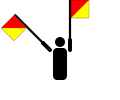 T |
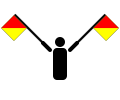 U | |
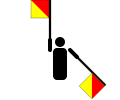 V |
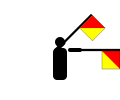 W |
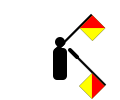 X |
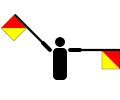 Y |
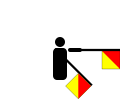 Z |
c. Send and receive by International Morse Code at the rate of eight words per minute using wigwag flags. (Five-letter words, minimum of 20 words.)
In order to send Morse Code via wigwag flag, one must obviously first learn Morse Code. See section a for details. Second, one must know how to transmit dots and dashes with the wigwag flags. The sender holds two flags, one in each hand. The "rest" position is both flags straight up. To send a dot, the flag on the right is lowered straight out to the right and then raised again. To send a dash, the left flag is lowered straight out to the left and then raised again.
References
- Wikipedia article on Morse Code
- Wikipedia article on Semaphores
- http://www.cromwellbutlers.com/sbb_0617.htm

